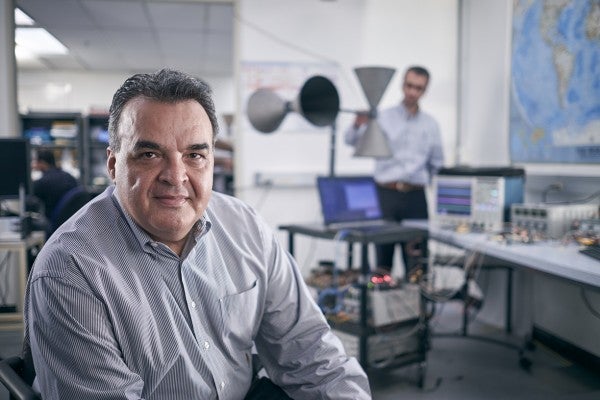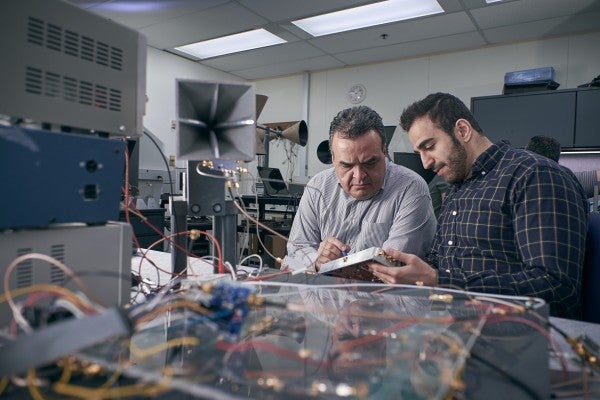
Two-way wireless technology
Developing pioneering two-way wireless technology offering exceptional voice and data services

Developing pioneering two-way wireless technology offering exceptional voice and data services
By Kira Vermond Faculty of EngineeringAlthough texting, emailing and streaming movies wirelessly may all seem to hinge on highly-powerful and efficient technology, today’s wireless systems actually have much in common with low-tech walkie-talkies. They either send or receive data—never at the same time, which means they are one-way.
 But now a Waterloo engineering research team, led by Amir K. Khandani, an electrical and computer engineering professor and the Canada Research Chair in Wireless Systems, is developing pioneering two-way wireless technology offering exceptional voice and data services. Although two-way wireless systems were once widely considered an impossibility due to a large amount of self-interference, Khandani has shown that not only are they feasible, they have the ability to revolutionize the communications industry.
But now a Waterloo engineering research team, led by Amir K. Khandani, an electrical and computer engineering professor and the Canada Research Chair in Wireless Systems, is developing pioneering two-way wireless technology offering exceptional voice and data services. Although two-way wireless systems were once widely considered an impossibility due to a large amount of self-interference, Khandani has shown that not only are they feasible, they have the ability to revolutionize the communications industry.
The timing couldn’t be better for his research into two-way wireless technology, which allows data to move back and forth simultaneously. He was recently awarded $520,000 in funding from the Natural Sciences and Engineering Research Council (NSERC) and $3.4m in an Ontario Research Fund – Research Excellence (ORF-RE) towards the project he’s leading to support 5G networks. With 50 billion smart devices estimated to be online by 2020, Khandani is working on new techniques to double the rate of information exchanged over the same bandwidth, in addition to enhancing wireless security.
“Right now the systems are so fast between transmit and receive mode that we don’t feel the lag, but the truth of the matter is, in order to switch between transmit and receive, we cause a delay and waste a lot of spectrum, and this is on top of wasting half of the spectrum due to using one-way technology” says Khandani.
Engineering research to develope more efficient two-way wireless technology is vitally important as consumers become increasingly addicted to staying connected via their smart phones, tablets, laptops and other high-tech devices. Meanwhile, tomorrows wireless systems will be expected to keep up by supporting much higher bit rates at a lower cost.
Not only would ultra efficient two-way wireless help solve that problem and double throughput transmissions, it would become much more secure. Wireless networks would no longer depend on encryption open to hacking by anyone with the radio software and hardware to do the deed. In other words, yes, you might actually bank online at your local coffee shop using the public Wi-Fi without fear.
Khandani says the University of Waterloo’s Intellectual Property Rights policy, which grants ownership of intellectual property to its creators, and its attitude toward theoretical and practical research, has helped make breakthrough technology happen in Waterloo Engineering.
 “When I approach the government for funding to take my team’s developed technology to the next level as a means to serve public interest, I know the University is there to support me,” he says.
“When I approach the government for funding to take my team’s developed technology to the next level as a means to serve public interest, I know the University is there to support me,” he says.
That support creates what is essentially a “funding circle.” More funding creates the ability to build world-class labs, more equipment, and some of the most innovative technology in North America. It is a key element to engineer the future. That bolstered infrastructure makes it easier for engineering researchers, including undergraduate and graduate students, to create the technologies of tomorrow. In return, those successes both in the lab and industry inspire more funding.
“Our infrastructure is very strong,” explains Khandani. “We can build anything we need right here at Waterloo. We are not reliant on other institutions’ labs, machines or technology to do our engineering research or create something innovative and new. We can get it done here, fast and cost effective.”

Engineering master's student Nayeema Nonta (left), one of the three paper authors, and her supervisor, Dr. Sirisha Rambhatla, in a large server room with the computer power needed to develop their new LLM training technique. (University of Waterloo)
Read more
Waterloo researchers develop highly efficient AI training system that paves the way for cheaper, greener “intelligent partners”

Read more
Engineering researchers team up to tackle the plastics pollution problem with microbial innovation and engineering design

Read more
15 University of Waterloo researchers have been named to the annual Highly Cited Researchers™ list for significant contributions to their specific fields of research
Read
Engineering stories
Visit
Waterloo Engineering home
Contact
Waterloo Engineering
The University of Waterloo acknowledges that much of our work takes place on the traditional territory of the Neutral, Anishinaabeg, and Haudenosaunee peoples. Our main campus is situated on the Haldimand Tract, the land granted to the Six Nations that includes six miles on each side of the Grand River. Our active work toward reconciliation takes place across our campuses through research, learning, teaching, and community building, and is co-ordinated within the Office of Indigenous Relations.